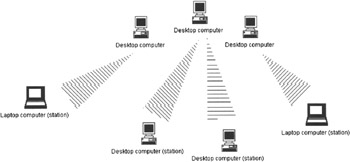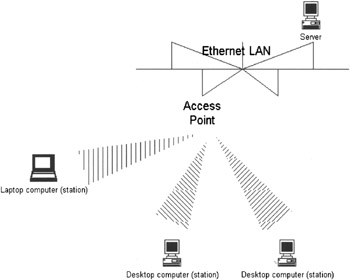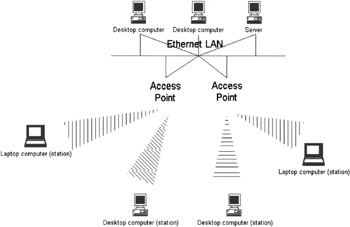802.11 Architecture
|
|
IEEE 802.11 supports three basic topologies for WLANs: the IBSS, BSS, and ESS. All three configurations are supported by the MAC layer implementation.
The 802.11 standard defines two modes: ad hoc/IBSS and infrastructure mode. Logically, an ad hoc configuration is analogous to a peer-to-peer office network in which no single node is required to function as a server (see Figure 2-6). IBSS WLANs include a number of nodes or wireless stations that communicate directly with one another on an ad hoc, peer-to-peer basis, building a full-mesh or partial-mesh topology. Generally, ad hoc implementations cover a limited area and are not connected to any larger network.

Figure 2-6: Wireless ad hoc network
Using infrastructure mode, the wireless network consists of at least one AP connected to the wired network infrastructure and a set of wireless end stations. This configuration is a BSS (see Figure 2-7). Since most corporate WLANs require access to the wired LAN for services (file servers, printers, and Internet links), they will operate in infrastructure mode and rely on an AP that acts as the logical server for a single WLAN cell or channel. Communications between two nodes, A and B, actually flow from node A to the AP and then from the AP to node B. The AP is necessary to perform a bridging function and connect multiple WLAN cells or channels as well as connect WLAN cells to a wired enterprise LAN.

Figure 2-7: Wireless BSS
An ESS is a set of two or more BSSs forming a single subnetwork. ESS configurations consist of multiple BSS cells that can be linked by either wired or wireless backbones. IEEE 802.11 supports ESS configurations in which multiple cells use the same channel and use different channels to boost aggregate throughput (see Figure 2-8).

Figure 2-8: 802.11 ESS
802.11 Components
802.11 defines two pieces of equipment, a wireless station, which is usually a PC equipped with a wireless NIC, and an AP, which acts as a bridge between the wireless and wired networks. An AP usually consists of a radio, a wired network interface (802.3, for example), and bridging software conforming to the 802.11d bridging standard. The AP acts as the base station for the wireless network, aggregating access for multiple wireless stations onto the wired network. Wireless end stations can be 802.11 PC card, Peripheral Component Interconnection (PCI), or Industry Standard Architecture (ISA) NICs, or embedded solutions in non-PC clients (such as an 802.11-based telephone handset).
An 802.11 WLAN is based on a cellular architecture. Each cell (BSS) is connected to the base station or AP. All APs are connected to a DS, which is similar to a backbone, usually Ethernet or wireless. All mentioned components appear as an 802 system for the upper layers of OSI and are known as the ESS.
The 802.11 standard does not constrain the composition of the DS; therefore, it may be 802 compliant or nonstandard. If data frames need to transmit to and from a non-IEEE 802.11 LAN, then these frames, as defined by the 802.11 standard, enter and exit through a portal. The portal provides logical integration between existing wired LANs and 802.11 LANs.
When the DS is constructed with 802-type components, such as 802.3 (Ethernet) or 802.5 (Token Ring), then the portal and the AP are the same, acting as a translation bridge. The 802.11 standard defines the DS as an element that interconnects BSSs within the ESS via APs. The DS supports the 802.11 mobility types by providing the logical services necessary to handle address-to-destination mapping and the seamless integration of multiple BSSs. An AP is an addressable station, providing an interface to the DS for stations located within various BSSs. The IBSS and ESS networks are transparent to the LLC layer.[14]
Mobility
The mobility of wireless stations may be the most important feature of a WLAN. The chief motivation of deploying a WLAN is to enable stations to move about freely from location to location either within a specific WLAN or between different WLAN segments.
For compatibility purposes, the 802.11 MAC must appear to the upper layers of the network as a standard 802 LAN. The 802.11 MAC layer is forced to handle station mobility in a fashion that is transparent to the upper layers of the 802 LAN stack. This forces functionality into the 802.11 MAC layer that is typically handled by upper layers in the OSI model.[15]
To understand this design restriction, it is first important to appreciate the difference between true mobility and mere portability. Portability certainly results in a net productivity gain because users can access information resources wherever it is convenient to do so. At the core, however, portability removes only the physical barriers to connectivity. It is easy to carry a laptop between several locations, so people do. However, portability does not change the ritual of connecting to networks at each new location. It is still necessary to physically connect to the network and reestablish network connections, and network connections cannot be used while the device is being moved.
Mobility removes further barriers, most of which are based on the logical network architecture. Network connections stay active even while the device is in motion. This is critical for tasks requiring persistent, long-lived connections, which may be found in database applications.
802.11 is implemented at the link layer and provides link-layer mobility. The Internet Protocol (IP) does not allow this. 802.11 hosts can move within the last network freely, but IP, as it is currently deployed, provides no way to move across subnet boundaries. To the IP-based hosts of the outside world, the virtual private network (VPN)/access control boxes are the last-hop routers. To access an 802.11 wireless station with an IP address on the wireless network, it is possible to simply go through the IP router to the target network regardless of whether a wireless station is connected to the first or third AP. The target network is reachable through the last-hop router. As far as the outside world can tell, the wireless station might as well be a workstation connected to an Ethernet.
A second requirement for mobility is that the IP address does not change when connecting to any of the APs. New IP addresses interrupt open connections. If a wireless station connects to the first AP, it must keep the same address when it connects to the third AP.
A corollary to the second requirement is that all the wireless stations must be on the same IP subnet. As long as a station stays on the same IP subnet, it does not need to reinitialize its networking stack and can keep its Transmission Control Protocol (TCP) connections open. If it leaves the subnet, though, it needs to get a new IP address and reestablish any open connections. Multiple subnets are not forbidden, but if you have different IP subnets, seamless mobility between subnets is not possible.
The single IP subnet backbone restriction is a reflection on the technology deployed within most organizations. Mobile IP was standardized in late 1996 in RFC 2002, but it has yet to see widespread deployment. Until Mobile IP can be deployed, network designers must live within the limitations of IP and design networks based on fixed locations for IP addresses. A backbone network may be physically large, but it is fundamentally constrained by the requirement that all APs connect directly to the backbone router (and each other) at the link layer.[16]
[14]Plamen Nedeltchev, "WLANs and the 802.11 Standard," a white paper from Cisco Systems, www.cisco.com/warp/public/784/packet/jul01/pdfs/whitepaper.pdf
[15]"Introduction to IEEE 802.11," a white paper from Intelligraphics, www.intelli-graphics.com/articles/80211_article.html.
[16]Gast, 295-296.
|
|
EAN: 2147483647
Pages: 96